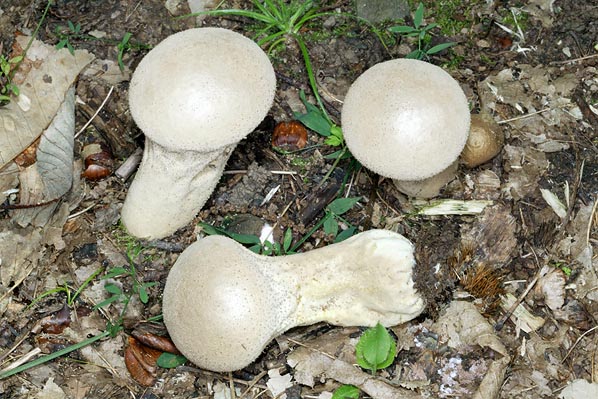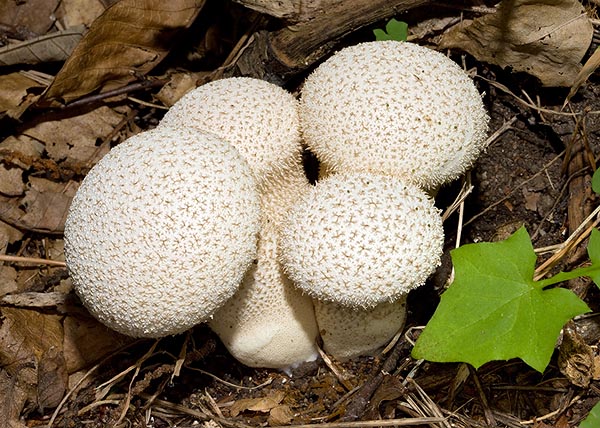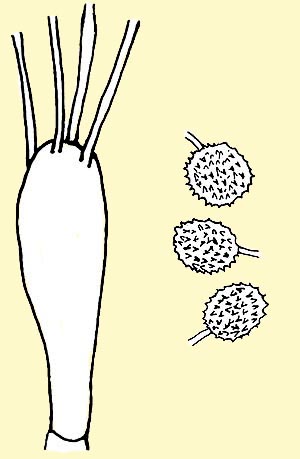
Text © Pierluigi Angeli

English translation by Mario Beltramini

The Calvatia excipuliformis is edible when young, till when the gleba is white © Giuseppe Mazza
Family: Lycoperdaceae Corda (1842).
Genus: Calvatia Fries (1849).
Calvatia excipuliformis (Pers. : Pers.) Perdeck (1950).
The name excipuliformis comes from the Latin “excipulum” = vessel, and “forma”, that is, having the shape of a vessel.
Description of the genus
The genus Calvatia is characterized by carpophores with a more or less flattened subglobose form, pyriform-turbinate, or pseudo-stipitate.
The carpophores are formed by a covering (peridium), having a protective function and containing the gleba (fertile part) and the sub-gleba (sterile part).
The peridium is composed by an “Exoperidium”, which is the outer layer of the peridium, which may be smooth or broken in wide smooth and flat areolas, dandruffy-tomentose, finely aculeate or warty with thick pyramidal warts, sharp and prominent; and by an “Endoperidium”, the inner layer of the peridium which encloses the gleba.

Just born Calvatia excipuliformis with its typical deciduous short spines © Giuseppe Mazza
The colour of the Exoperidium may vary from white to whitish or brownish-ochre, from reddish-ochre to brown violet.
The gleba, initially white, is firm and then becomes, thanks to the process of autolysis, a dusty dry mass containing the spores.
These are freed through an “ostiole”, apical opening, expressly programmed, or by the breakage of the whole peridium.
The subgleba is a portion supporting the fertile part and has more or less the same structure as the gleba, but is sterile; it may be absent or present, in which case it is rudimentary, that is, just perceptible pr well developed and more or less extended.
Description of the species
Carpophore: up to 15 cm tall fructiferous body with a diameter up to 10 cm. The head is roundish, spherical or just flattened, at times with a not much pronounced umbo, sustained by a big and long pseudo-stem, more or less cylindrical, enlarged or attenuated at the base, at times pleated or even scrobiculated, wrinkled.
Exoperidium: its surface, initially white, then caffe latte, finally brownish, is covered by small deciduous aculea which confer it a grainy appearance.

Calvatia excipuliformis: basidium and spores ©Angeli
Endoperidium: frail, thin, chartaceous, not visible as it breaks jointly with the exoperidium.
Gleba: composed by a fertile part (placed on the upped part of the fungus) and by a sterile one (placed in the lower part of the same); the separation of the fertile gleba from the sterile one is marked by a pseudo-diaphgram not always visible; the colour is white at the beginning, then greenish, brown-black when ripe; powdery.
Habitat: it grows in summer and autumn in the airy forests, in the meadows, in the grass, from the plain to the limit of the Alpine micro-forest.
Edibility: edible when young till when the gleba is white.
Microscopy: globose spores, sub-spherical, with the remainder of the sterigma rather short up to 2-2,5 µm, warty, guttulated, 4,2-5-5,5 µm. Tetrasporic basidia, club-shaped, without joint buckles, 13-15 × 6,5-7,5 µm.
Remarks: it is a species typified by the more or less slender shape, with a pseudo-stem well developed and at times very long.
However, this fungus may be mistaken with Calvatia utriformis (Bull.: Pers.) Jaap, which has, anyway, the outer surface of the exoperidium wrinkled at first, then chiselled, of bigger size and the spores are smooth at the optical microscope; the Lycoperdon perlatum Pers.: Pers., which has on the contrary, the outer surface covered by longer and detersile spines which leave on the surface some scars forming a network and the spores are smaller.
Synonyms: Lycoperdon excipulum Per. : Pers. 1801; Lycoperdon saccatum Fr. 1825; Lycoperdon elatum Massee 1887.
→ For general notions about Fungi please click here.
→ To appreciate the biodiversity of MUSHROOMS please click here.
